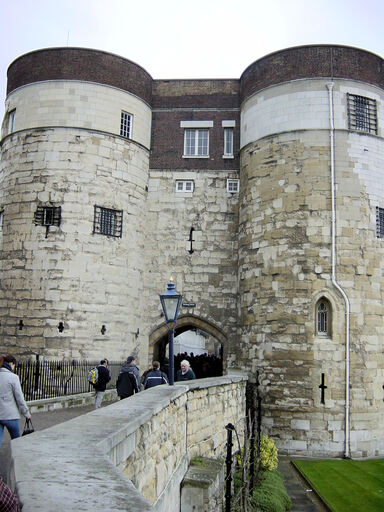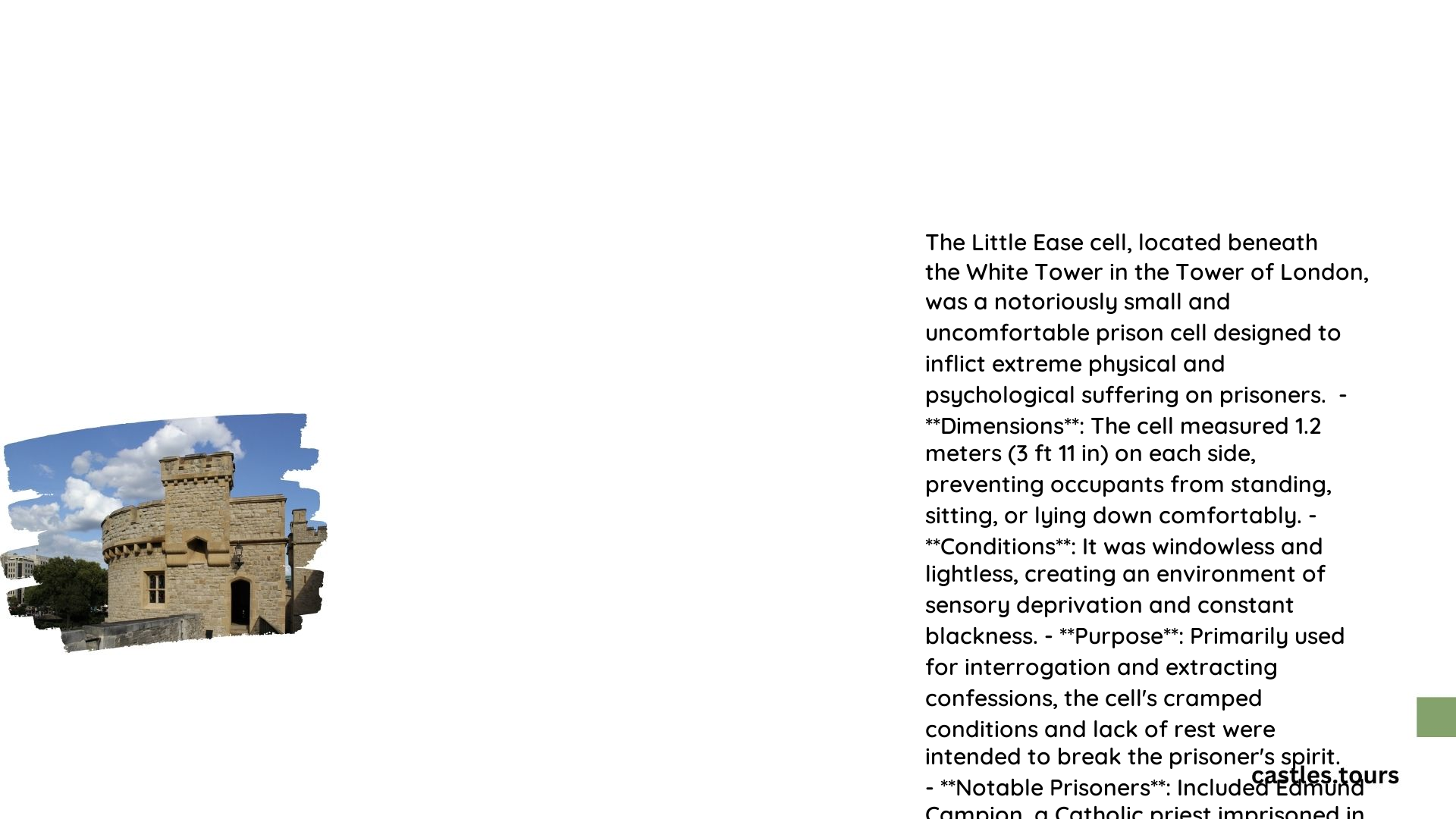The Little Ease cell in the Tower of London was a notorious torture chamber, infamous during the Tudor and early Stuart periods. Measuring only 1.2 square meters, this tiny space was designed to inflict both physical and psychological pain on prisoners. Located either in the White Tower’s dungeon or the old Flint Tower’s basement, Little Ease forced inmates to crouch in agony, unable to stand, sit, or lie down. This cruel confinement played a significant role in extracting confessions from notable prisoners like Guy Fawkes.
What Was the Purpose of the Little Ease Cell?

The Little Ease cell served as a brutal instrument of torture and interrogation within the Tower of London. Its primary purposes were:
- Physical torment
- Psychological breakdown
- Extraction of confessions
- Punishment for perceived crimes
The cell’s design was intentionally cruel, forcing prisoners into an unnatural and painful position for extended periods. This constant discomfort, combined with isolation and darkness, often led to rapid mental and physical deterioration.
Where Was the Little Ease Cell Located?

The exact location of the Little Ease cell remains a subject of historical debate. However, most scholars believe it was situated in one of two possible locations:
- The dungeon of the White Tower
- The basement of the old Flint Tower
The White Tower, being the oldest part of the Tower of London complex, is considered the most likely site. This central keep, with its thick walls and formidable presence, would have been an ideal location for such a secretive and feared chamber.
Who Were Some Famous Prisoners of the Little Ease Cell?
Several notable figures in British history were subjected to the horrors of the Little Ease cell. Some of the most famous prisoners include:
| Prisoner | Crime | Year |
|---|---|---|
| Guy Fawkes | Gunpowder Plot | 1605 |
| John Bawd | Aiding a prisoner’s escape | 16th century |
| Stephen Happes | “Lewd behavior and obstinacy” | 16th century |
Guy Fawkes, perhaps the most infamous occupant of Little Ease, was tortured there following his involvement in the Gunpowder Plot of 1605. After enduring the rack, Fawkes was confined to Little Ease until he confessed and revealed his co-conspirators’ names.
John Bawd, a yeoman warder, found himself imprisoned in Little Ease for attempting to help a condemned thief named Alice Tankerville escape. This case highlights how even those employed within the Tower system could fall victim to its harshest punishments.
Stephen Happes, though less well-known, represents the broader use of Little Ease as a tool for enforcing social and moral conformity. His confinement for “lewd behavior and obstinacy” demonstrates how the cell was used not only for political prisoners but also for those deemed socially deviant.
How Long Did Prisoners Typically Spend in Little Ease?
The duration of confinement in Little Ease varied greatly depending on the prisoner and the circumstances of their imprisonment. Factors influencing the length of stay included:
- The severity of the alleged crime
- The prisoner’s willingness to confess
- The interrogator’s satisfaction with obtained information
- The physical endurance of the prisoner
Some prisoners might have spent only a few hours in Little Ease as a form of intense, short-term torture. Others, particularly those resisting interrogation, could have been confined for days or even weeks. However, due to the extreme conditions, prolonged stays often resulted in severe physical damage or death.
What Were the Physical Conditions Inside Little Ease?
The Little Ease cell was designed to maximize discomfort and suffering. Its key features included:
- Extremely small dimensions (approximately 1.2 square meters or 4 square feet)
- No space to stand upright, sit comfortably, or lie down
- Dark, with little to no natural light
- Poor ventilation
- Damp and cold stone walls
These conditions forced prisoners to maintain an awkward, crouched position that quickly became agonizing. The lack of movement, combined with the cold and damp environment, led to muscle cramps, joint pain, and circulation problems.
How Did Little Ease Compare to Other Torture Methods Used in the Tower?
While the Tower of London was home to various torture devices and methods, Little Ease stood out for its psychological impact. Here’s a comparison:
- The Rack: Stretched limbs, causing extreme pain and joint dislocation
- Scavenger’s Daughter: Compressed the body, opposite of the rack
- Manacles: Suspended prisoners by their wrists, dislocating shoulders
- Little Ease: Constant discomfort, sleep deprivation, and mental anguish
Unlike more active forms of torture, Little Ease relied on prolonged confinement to break the prisoner’s will. Its effectiveness lay in the relentless, inescapable nature of the discomfort it inflicted.
Why Is Little Ease No Longer Accessible to Visitors?
Little Ease is not part of the current tourist attractions at the Tower of London for several reasons:
- Historical uncertainty: The exact location remains debated
- Structural changes: The cell may have been demolished or walled up
- Preservation concerns: If it exists, access might damage the site
- Ethical considerations: Displaying such a site raises moral questions
After Guy Fawkes’ confession, Little Ease reportedly fell into disuse. Over time, it was either intentionally sealed off or became inaccessible due to structural changes within the Tower complex.
What Can Visitors See Today Related to Little Ease?
While Little Ease itself is not accessible, visitors to the Tower of London can explore related historical sites and exhibitions:
- The White Tower: Possibly home to Little Ease, this central keep houses historical displays
- Torture at the Tower exhibition: Provides information on various torture methods used
- Yeoman Warder tours: Often include stories about the Tower’s darker history
- The Bloody Tower: Another site associated with imprisonment and torture
These attractions offer insights into the Tower’s role as a prison and the use of torture during the Tudor and Stuart periods.
How Has the Legacy of Little Ease Influenced Modern Views on Torture?
The notorious reputation of Little Ease has contributed to broader discussions about torture and human rights:
- Historical perspective: Illustrates the evolution of judicial practices
- Psychological impact: Highlights the cruelty of prolonged confinement
- Human rights awareness: Contributes to debates on prisoner treatment
- Cultural impact: Featured in literature, films, and historical documentaries
The cell’s legacy serves as a stark reminder of past cruelties and informs ongoing debates about interrogation techniques and prisoner rights in the modern world.
In conclusion, while the Little Ease cell in the Tower of London may no longer be visible to visitors, its impact on history and our understanding of torture practices remains significant. This tiny chamber, designed to break both body and spirit, stands as a grim testament to a darker period in British judicial history. Today, it serves as a powerful reminder of the importance of human rights and the ongoing need to guard against cruel and inhumane treatment in all forms of detention and interrogation.
References:
1. https://www.youtube.com/watch?v=PSLHYzDx_Hw
2. https://www.rct.uk/collection/2102216/little-ease-torture-cell-beneath-the-white-tower
3. https://www.thevintagenews.com/2018/04/21/little-ease/
